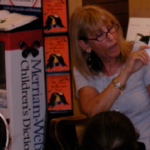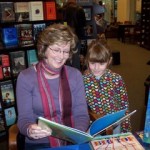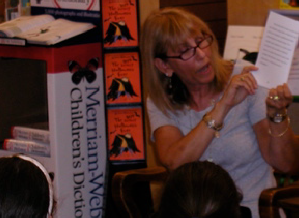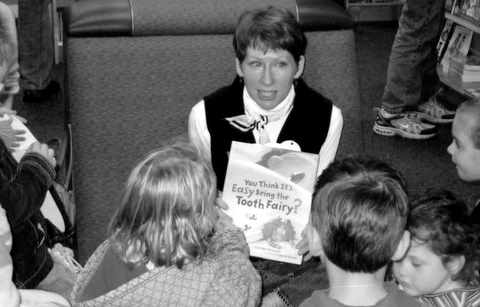Last year Rachelle critiqued one of my picture book manuscripts. After her help, I sent my requested revision back to the editor, a few months later, I found out it had gone to an acquisitions meeting with this major publisher, but it did not have enough support to be purchased. I credit Rachelle for helping my manuscript get that far, the closest I’ve ever come to selling a picture book.
Today, she was nice enough to answer some questions for the readers of GotInterviews.com.
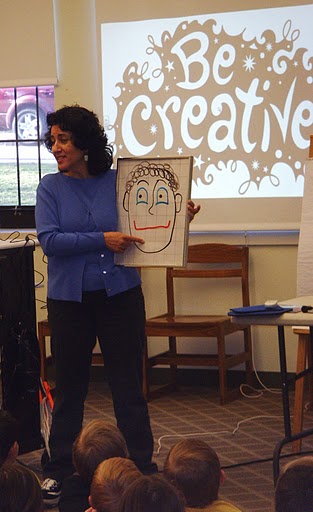
Rachelle in Action
It may be unknown to some people, but you are a very talented children’s entertainer. How long have you been getting paid to act like a clown?
It might look like I’m blushing, but that’s just the face paint 🙂 I have been “Tickles the Clown” for about 16 years. I eventually added other characters: “Wacky Witch” for Halloween shows, “Tickles the Elf” for Christmas, and “Princess Meshugana” for Hanukkah and Purim. I also do storytelling programs as “Mother Goof.” Making kids happy is the best job in the world.
Many writers find author visits to be frightening. How has your experience as a children’s entertainer prepared you for author visits?
I think I’d be awfully nervous if I weren’t already accustomed to being in front of a crowd of kids–not to mention adults who are naturally assessing my program. Also, knowing how to make kids laugh results in an educational program that is entertaining as well.
You had your first book published (Tree House in a Storm) in 2009 by Stemmer House. Can you tell me a little bit about your journey to publication? Was it a long arduous journey or were you an overnight success?
Don’t I wish it was an overnight success! No, I worked long and hard for it. In my early years of writing I got only rejection letters from book publishers. I would have concluded that I just wasn’t a very good writer, but then I decided to submit to magazines. One day I got an acceptance from Highlights Magazine and was on top of the world. Literally the very next day they accepted another story I’d also submitted. Ten months later a third. This success gave me confidence to continue submitting appropriate manuscripts to book publishers. I did get plenty of rejections for Tree House in a Storm before landing a publisher. I use these rejection letters in my author visits to discuss the revision process.
You write about some amazing topics. Recently you wrote about a painter who has been blind from birth. Can you tell us more about this story and how you came up with the idea?
Once when googling something unrelated, I got a hit for a site about a congenitally blind painter named Esref Armagan. It piqued my curiosity enough to stray from what I was doing and read about it. I was immediately hooked, and ended up reading everything I could about him, including medical and psychological journal articles. I was determined to write a children’s biography about this amazing man. He lives in Turkey and speaks no English, but that didn’t stop me. I contacted his manager–an American woman living in Turkey–and conducted 3-way Skype interviews (with her as interpreter). The book is complete and I’ve even acquired a number of expert reviews, but, as one editor told me, it will be hard to sell in the US since Esref is virtually unknown here. While I continue to submit to educational publishers in the US, I’ve begun seeking an agent in Turkey or England.
A lot of your stories are vey helpful in a classroom setting, how do you see teachers using the story of Esref with their students?
His story would be beneficial in both art and science curricula. In the book, I go into detail about how this man, who has not seen so much as light or shadow, actually paints realistic images with color, perspective, and shadows. Scientists at Harvard have studied his brain, making breakthroughs in the area of perception and the brain. Most of all, Mr. Armagan is an example of breaking barriers. Never underestimate what motivated people can do.
Not only have you had a book published, you’ve also had many articles published in magazines such as Highlights, Pockets, Birds & Bloom and some Scholastic titles. Do you receive more joy from writing book manuscripts or articles?
When I started writing, I thought nonfiction was dull and had no interest in it. But then I discovered that when something fascinated me, whether a fiction or nonfiction idea–I wanted to write about it. Some of these manuscripts were more appropriate as magazine pieces, and I’m fine with that. One day I was surprised to receive a check from Highlights. They had sold a nonfiction story they’d published a year or two ago to an educational testing service, resulting in new royalties. I like knowing hundreds of kids will be reading it (even if it’s because they have to).
Looking over your list of published works, I see you write a lot about physical or emotional challenges. Can you share why you have a tendency to write about these circumstance?
Perhaps my interest seeing how people overcome barriers is consistent with my other career (I’ve been a social worker a lot longer than I’ve been a clown!). I find such stories inspiring. But while I’ve had work published about a blind skier (Highlights), skiers with other handicaps (Scholastic Scope) and a child’s recovery from cancer (Catholic Forester Magazine), I’ve also written about the tooth fairy, an orphaned squirrel, and missing socks. I don’t limit myself to any particular theme.
You write. You entertain. You also offer a critique service for other writers. How does your service work?
I have published fiction, nonfiction and poetry for children, and so am open to critiquing all three types of kidlit. Writers send me their work as email attachments. I’ve had clients from the US, Canada, the UK, India, Australia, and Mexico. My website has a link to my service, which provides details, including my affordable fees. References are also on the site.
You have had many clients use your critique service over the years. Do you find your clients are committed writers looking to improve, or people who give picture book writing a shot because it seems a fun thing to do?
Most are serious but new writers. Writers who are just doing it for enjoyment wouldn’t typically look for a critique group or critique service. That indicates a level of commitment
Since you run a critique service, do you have time to be part of a critique group? If you are part of a group, how do you benefit?
| I’ve been part of several critique groups over the years. I am currently in two (in-person and online) which have been together for several years. Once I started a new group just for chapter books. |
Being active in critique groups is the one thing that advanced my writing the most. New writers often believe that a thumbs-up from their family member/kids/teacher/librarian is evidence of good writing. Unless the person providing feedback is a writer who can dissect a picture book or article, the only real benefit is a boosted ego. My website, www.ResourcesForChildrensWriters.com, has a category for critique groups, with links to sources for finding one to join. They are free.
Only two more questions….
Can you give me a list of your five favorite picture books you read or had read to you as a child and your five favorite picture books on the market today?
I can’t honestly say I was a big reader as a kid. I mostly liked to write and draw. But I remember a few books I loved as a child: The Little Engine that Could, The Pokey Little Puppy, and a lot of Dr. Seuss books. When I was a bit older my favorites were Charlotte’s Web and Stuart Little.
My list of current favorites is long. I love Toni Buzzeo’s lyrical writing in The Sea Chest. Eileen Spinelli is my idol when it comes to rhyming picture books. The Zack Files (early chapter book series by Dan Greenburg) make me pee in my pants from laughing so hard. I’m in awe of Donna M. Jackson, who writes nonfiction science books (for ages 9-12) in a way that is can’t-put-downable and easy to understand.
Finally, can you share one thing about yourself that friends and fans can find out only from reading this interview? Remember, this doesn’t have to be about writing.
I collect frog figurines. I must have over a hundred of them–marble, glass, carved wood, jade, pewter, metal–including many from other countries. We also even have a real 13-year-old aquatic frog that my daughter got as a tadpole. As it turns out, the illustrator of my book, Rex Schneider, has a thing for frogs as well. This led to my suggestion that he hide them in all the pictures of our book. And he did.
To learn more about Rachelle and her writing, please visit www.Rachelleburk.com. To learn more about writing, visit her Resources site which as over 250 links within 30 distinct categories. You can find it at www.ResourcesForChildrensWriters.com. It has won two awards, including the Preditors and Editors Very Useful Site Award!
To buy Rachelle’s book Tree House in a Storm, click the Amazon link below

